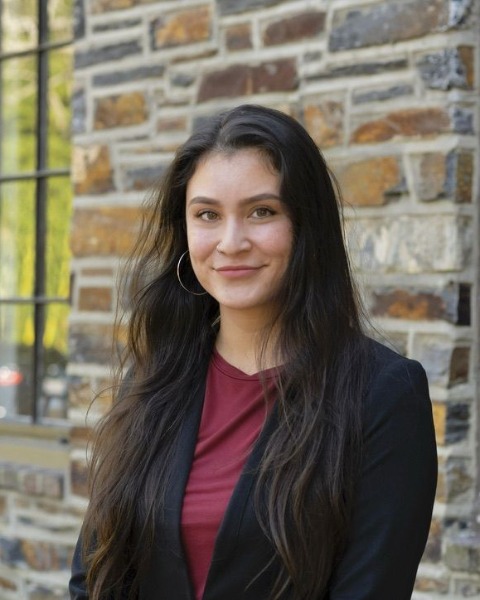Cardiovascular Engineering
Cardiovascular Engineering - Poster Session C
Poster U9 - Modeling Oxidative Stress in Small Arteries In Vitro
Friday, October 25, 2024
10:00 AM - 11:00 AM EST
Location: Exhibit Hall E, F & G

Claudia S. Wong, BS (she/her/hers)
PhD Candidate
Duke University
Durham, North Carolina, United States- SG
Sharon Gerecht, PhD
Professor
Duke University, United States
Presenting Author(s)
Primary Investigator(s)
Introduction: In vitro models of the vasculature provide a reproducible and controlled environment to explore various pathologies. The more physiologically accurate the model, the better that vascular structure and function are properly mimicked, thus reducing errors in results attributed to modeling in vitro. However, producing small vessels less than 3 mm in diameter that are stable can be challenging compared to more common microvascular network or large vessel models. When modeling blood vessels, the chosen endothelial cell (EC) phenotype should best match the application due to the unique roles they serve and the variation in their phenotypes.
Oxidative stress is an imbalance between reactive oxygen species and antioxidants that can damage tissue and is present in various cardiovascular diseases. Oxidative stress is also a high-risk space stressor that affects several organs in astronauts, including small arteries. Space flight is shown to dysregulate free radical normalization in the body, including downregulation of the antioxidant gene nuclear factor erythroid 2-related factor 2 (Nrf2).
Our lab has created a 3D graft model made of electrospun fibrin hydrogel microfibers that can be seeded with a monolayer of ECs to line the lumen of the graft, thus forming a stable in vitro replica of a small blood vessel less than 3 mm in diameter. Here, we hypothesize that these fibrin grafts seeded with arterial ECs can be used to study the effects of oxidative stress in small arteries when using Nrf2 knockout stem cells to genetically induce oxidative stress.
Materials and
Methods: Induced pluripotent stem cells (iPSC) are differentiated into nonspecific ECs or arterial ECs using published protocols. EC identity is verified by testing for VE-Cadherin and CD31 and arterial marker SOX17 using flow cytometry and immunofluorescence staining. Functional assays are performed consisting of (1) inflammatory response by exposing ECs to bacterial lipopolysaccharide for 24 hours and comparing cellular expression via immunofluorescent staining of inflammatory marker ICAM-1 to nonexposed cells, and (2) network formation by seeding ECs in 3D collagen gels and examining immunofluorescent images for the ability of ECs to form networks. Fibrin grafts are generated by following the published protocol, where fibrinogen is electrospun into a thrombin bath and then rolled in layers around mandrels, creating a graft that is 0.5 mm in diameter and 4 mm in length. ECs are injected into fibrin grafts and rotated while settling to create a monolayer of cells on the luminal graft surface. Grafts are cultured for 48 hours and then examined for proper seeding and growth of ECs by immunofluorescent staining of endothelial markers and F-actin.
Similar experiments are performed using Nrf2 knockout iPSCs to determine the effects of oxidative stress on arterial ECs. Reactive oxygen species in grafts are measured using CellROX cytometry.
Results, Conclusions, and Discussions: iPSCs were successfully differentiated into nonspecific ECs and arterial ECs. All ECs expressed endothelial marker VE-Cadherin and arterial ECs expressed arterial marker SOX17 (Fig. 1A, 1B). All ECs formed networks in collagen gels (Fig. 1C) and upregulated inflammatory marker ICAM-1 in response to inflammation with bacterial lipopolysaccharide (Fig. 1D), as reported previously. Stable fibrin grafts 0.5 mm in diameter were successfully electrospun and supported the attachment and proliferation of arterial ECs, forming a biomimetic small artery model (Fig. 1E). Studies with the knockout Nrf2 iPSCs are upcoming.
The in vitro model of small arteries produced is highly physiologically relevant, where the fibrin grafts are properly sized while being stable and the ECs utilized exhibit an arterial phenotype. In vitro modeling of small arteries allows for reproducible and controlled experiments. By using iPSCs, this experiment can be done with people of diverse backgrounds and studied in different organ systems, additionally, studies can be personalized to specific astronauts or cardiovascular disease patients. The model produced in this study can greatly increase our understanding of how oxidative stress affects small arteries.
Acknowledgements (Optional):
